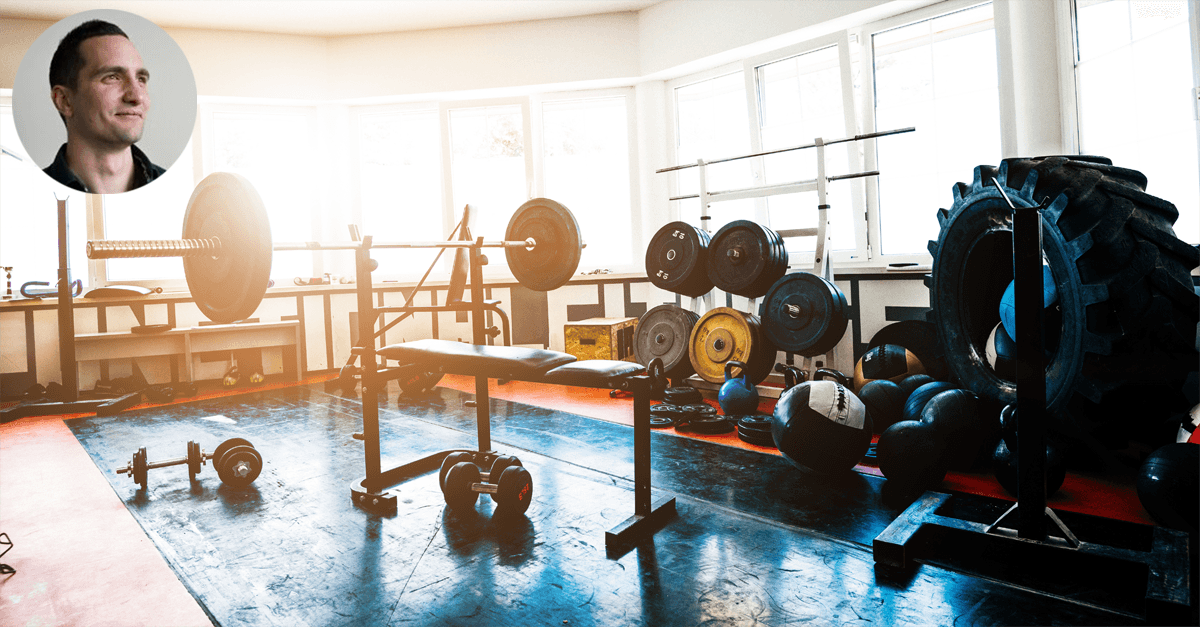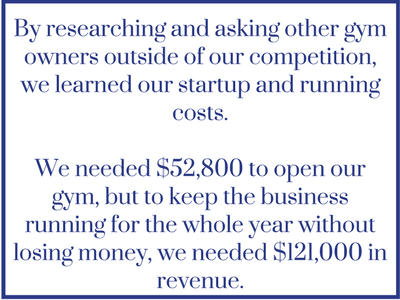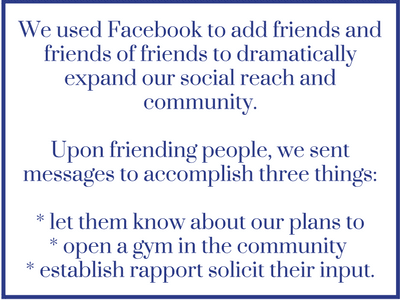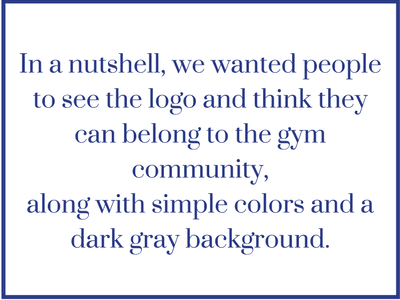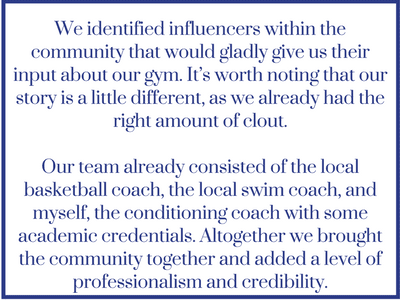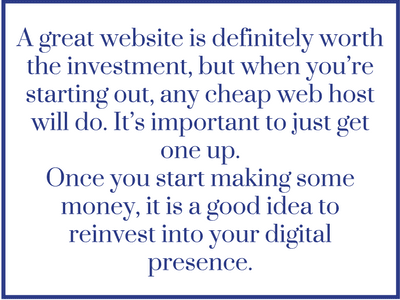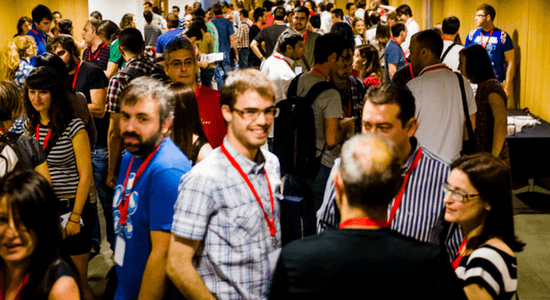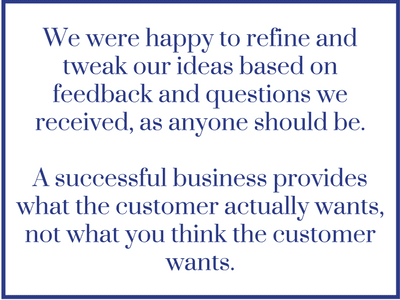I recently opened my own gym, called Central Fitness, with my two partners, and in just 14 days, we generated $202,540 of annual revenue in gym memberships.
We successfully signed 205 gym members, all of whom had their annual membership paid in full before we even opened our doors to the public. I understand if this sounds too good to be true, but this is no fairy tale. In this article about opening a gym, I’ll lay out exactly how we did from wondering how to open a gym to getting our signed contracts, it so you can learn and apply our strategies to your own business, too.
Our idea was to open a gym in the area, but with one key difference from the competitors: We would be a 24-hour facility.
-
(Note from The PTDC's Jon Goodman: It may seem like a lot of gyms already exist in your city. What’s important is to do an analysis of, as Al Ries and Jack Trout say in their book, Positioning: The Battle for Your Mind, the “chinks in the market leader’s armour.” This is a good example of that, where Kale was able to identify a quiescent desire in his market for a 24-hour access gym at a lower price point and positioned his facility to fill that need.)
-
Neither I nor my partners had opened a commercial gym before. Being a conditioning coach who had just taken the leap to learning business strategy, I wanted to develop a gym business plan and method that would allow us to keep our existing jobs and projects, test the market before investing significant capital, and find a significant point of difference to set us apart from our competitors.
There are many factors to consider when starting your own gym and this article is extremely detailed. For ease of navigation there are 6 sections. You can read this start to finish or skip to whatever section you prefer.
1. Created a budget for our fitness business
2. Found champions to support our gym idea and leveraged these influencers
3. Created a story that our community was happy to spread to their friends
4. Spread the word of our gym through word-of-mouth gym marketing
6. Got more than 200 paying clients before our gym opened
We’ve included scripts, examples of our spreadsheets, and so much more throughout to help make this as crystal-clear and replicable for you as possible.
If you prefer, we've compiled this case study as a free .pdf for you to download and reference back at your leisure. Simply enter your email in the box below to get it sent to your inbox.
Let’s get started!
Step 1: Create a budget for our gym business
For many personal trainers, opening their own gym is the pinnacle of their careers, but as with any business there are a lot of risks to factor into your plans. Even with extensive research, there are no guarantees it would be a success. One of the biggest questions is, what’s the cost of opening a gym?
Our initial research showed us it would cost approximately $52,000, which we laid out in a spreadsheet.
We then had to consider the minimum number of new members necessary to even out the cost of starting the gym and keeping the lights on. In other words, we had to figure out:
* Our startup and running costs
* Prices for our gym membership prices
Researching the startup and running costs of opening our gym
Two important variables to consider during the research phase are the amount of capital needed to start the venture and the amount of money needed to have the business run for a year. These are known as your startup cost and running cost, respectively. A startup cost, as you can probably guess, is how much you need to set up the gym. Running costs are those that you will incur once you open your gym doors. These include rental property costs, insurance, paying employees, and so on.

In our research, we looked at multiple sources for this information, including a fitness equipment distributor from China, consulted our friends, and had a possible (but unconfirmed) location in mind. The goal of this whole process was to find out these startup and running costs of our gym before committing to any one thing or location.
The best way for us was to simply ask other gyms who weren’t in our target location. The reason is, we didn’t want to let the competition know we were opening a certain place until we had confirmed the idea.
Surprisingly, the gyms we approached obliged to our questioning. We interviewed a 24-hour franchise gym and two other independently owned gyms that were as close to our visions of our own gym. We simply called them and asked,
“Hey, we are looking at opening a gym 250 kilometers away from you. Can you share your startup costs for your gym and the approximate running costs for your gym?"
(From Jon: I’m surprised and happy that Kale had a good response when he asked other gyms for their startup costs. Hopefully, your response would be just as positive. The above example demonstrates the importance of asking because the worst thing that can happen is exactly what would happen if you don’t ask: a no.)
-
Based on their responses, we found that the cost for franchises was much higher than setting up an independent gym. The operational costs were also much more expensive for a franchise, as they had to pay a certain figure each year for marketing.
Based on the feedback from gyms, we knew that we needed to raise the following in order to open our doors:
* Operational gym gear - $25,000
* A security camera outfit - $7,000
* A property with the correct renovations - $10,000
* Clothing and logo designs - $2,000
We had learned in our research that one of the biggest mistakes new businesses make is running out of capital to keep the gym going. So, we buffered ours with a 20% margin of error for hidden or unexpected costs, which came out to be $8,800. Altogether, we needed $52,800 to open. This was the minimum amount we needed (with a little extra safety net).
Luckily for us, once we validated our idea, we were able to split the startup costs between the partners. If we had borrowed, we would have had to add loan repayments to our running costs.
Again, this was the bare minimum we needed without needing to take money from the business ourselves. That meant creating revenue, and to do that, we needed to have members and a sound membership pricing structure.
How we established our membership pricing
The gym membership prices will be the lifeblood of any gym’s business, so this step is crucial. When setting the prices, we asked these questions:
1. Is your gym going to offer a better service than your competitors? By “better service,” this may mean better equipment, hours, or trainers. Basically, what is your point of differentiation?
2. Can you offer a lower price point for the same service than other gyms are offering in your area?
I’m lucky to have had the privilege to work with professional sports teams and international athletes, so we were able to use my own trainer portfolio as an experience offer to our potential members. We also offered a 24-hour service, whereas our competitors were only open for limited number of hours. In addition, we had brand new equipment.

Based on all this, we answered yes to those questions, allowing us to outdo our competitors with a higher quality service at a lower price. Our competitors’ prices were as follows:
* Sign up for one year - $22 per week
* Sign up for six months - $24 per week
* Sign up three months - $28 per week
To stay competitive and also help us meet our running costs of $121,000 (which was, again, calculated in our spreadsheet under the Annual Running Costs tab), we settled on the following prices for weekly memberships:
* Sign up for one year - $19 per week
* Sign up for six months - $22 per week
* Sign up three months - $26 per week
The logic here: setting a lower price point would allow us to draw people away from competitors because we offered a better quality product at a lower price.
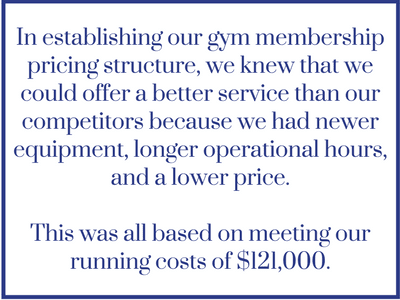
At these price points, we predicted that we would need a total of 123 members paying annual rate to make sure we could stay open in our first year.
Okay, great!
Now the next challenge was to actually find those people...
Step 2. Find champions to support your gym idea
Now that we had our idea and knew how much we needed to keep the business running, the next step was finding well-known people within the community to support our yet-to-be gym business. We needed key influencers in the community.
Luckily for us, we found the right people on Facebook and used their social network to test our community’s feedback before launching the concept of the gym. We did it by:
* Using Facebook to find influencers and see how people feel about our gym idea
* Creating our gym’s brand to get things moving
* Using these influencers’ network to get the word out
Here’s how it all went down.
Facebook is your main social media weapon
Let’s assume you’ve already added your closest friends on Facebook. Well, look through their friend’s lists and add 80 people you know you would be happy to talk to if you saw them in person. This opens up your network and also gives you access to the network of others.
For our purposes, we focused on friends in the community who had more than 500 friends. We wanted these friends to promote our new venture on our behalf, so having a large social reach was ideal. Here’s how to know if they meet your criteria:
1. You’ve spoken on more than one occasion.
2. One of their friends is also a close friend of yours and your friends on Facebook.
3. You trust them with your ideas.
This takes some initial vetting and legwork, but taking the time to build this network in the beginning is very crucial. Throughout building the reputation and promotion of our gym, we leaned on our network to help us.
The plan for us was to drum up anticipation and get people interested in going to an event we would host in order to sign up members (to be covered in Step 4). As you’ll soon see, this event was a key promotional driver of initial member sign-up and community interest, and we’ll get to how we planned it all out later.
The next thing we did was list all the reasons why we wanted to open our gym, why we thought the gym would work, what made it unique, and why it was a good fit for their community. Then we reached out to them, even if we didn’t know them, with a message like the following:
, how are you? What have you been up to lately?
I’ve got a new business idea to work in town. We’re looking at opening a 24-Hour gym in Central Otago. Haven’t decided on a name yet, but we’re pretty excited and we’re thinking of putting together an event to get people to check us out.
We want to get it out to as many people as possible, but we haven’t got that far yet. I will give you more info when we know what we’re up to!
* Let me know if you’ve got any advice for something like this?
* We’ve got two names so far Central Fitness or Hyper Fitness, which one do you think works better? Want to ask a couple of other people too?
* Do you know anyone else who would be good to share this project?
Looking forward to hearing from you.
The message was cordial, simple, and straightforward. It let them know what we were intending to do, created buy-in because they were a part of the project, and started the process of sharing our idea with their circle of friends.

By reaching out and asking questions, we were able to get in-depth and honest feedback on our brand, ideas, and our community. For example, one question we asked was:
“If you were able to go to our gym tomorrow, what changes or additions would you like to see?”
Creating our gym’s brand
Coming up with our gym’s name and identity was fun and important work. We came up with four names, selected the top two, and asked our friends to vote. If you want to get feedback, try sending someone:
Hey, one more favor please, could you and a couple of friends answer this question for us:
We’ve got two names so far: Central Fitness or Hyper Fitness. Which one do you think works better?
We’ve also decided upon a date for our opening event weekend to showcase the ideas about the gym, based on everyone’s feedback! It's next weekend, August 13-14, from 10 a.m. to 2 p.m. We'll be putting together a Facebook page tonight. It would be awesome if you’re there too.
Cheers,
Kale
Note that we mentioned an “event weekend.” We had no idea how we would pull it off at the time we sent this message, but we knew that once it was out there we would have had to figure it out quickly! (We cover this further down.) For now, we just wanted input for our name, and then get an overall look and feel for the brand.
None of us had a graphic design background, but the people at Fiverr did. We spent our first $6.50 NZD on getting a design made. We were specific about what we wanted and communicated them to the designer.
-
(From Jon: Getting started on Fiverr is fine if you don't have a budget, but expect to get a real designer to do your brand justice once you have revenue coming in. A logo and brand identity are paramount to a gym's success long term.)
-
Step 3. Create a story that the community can get behind and spread
People love to know the why of your business: Why did you create your own business? Why did you call it that name? And so on and so forth.
We were aware that we needed to create that story. Each story is unique to the business owner, but it should have these elements:
1. Your story has to focus on overcoming some obstacle or resolving an issue.
2. The issues needs to resonate with the people who are going to be your potential customers.
For Central Fitness, this was solving the issue of not having a 24-hour gym in town. A majority of our community had brought this to our attention, so we made this the main driving factor for our story. What we did was create a basic website to bring our concept to life, digitally, and use our network to attract press and public interest. In this step, we focused on:
* Getting more of the right people to support our brand and idea
* Creating a basic website and a Facebook page
* Preparing all the assets for our live registration event
Getting the right people on board
Previously, we had identified the friends in our community who had a large network. We next wanted to identify the people in our community who had influence or credibility when talking about exercise and fitness. For example, this could be that talkative, friendly lifter at the gym who seems to know more than trainers; or a lecturer you met during your studies. The goal is to get to know the people who are already doing what you would like to do.
You may think you don’t know anyone like this, but you know who does? Someone in your network. Here’s an example script that we used:
Hey bro,
I was just wondering if there are any people in the community you think of when you think of exercise and fitness?
We’re looking for someone who is local or near the community who could back our gym before opening and promote health and fitness alongside our open day. Could you name anyone specifically or send me an introduction to them please?
Cheers,
Kale
Once we were introduced or identified someone, we befriended them. Before sending them a message, we looked at why they loved what they do, why they were incredible people to talk to about health and fitness, and how we could share our own passion with them.

This is what I sent to someone whom I hadn’t met before:
Hey Brett,
It’s great to meet you. How long have you known Scotty? I wanted to share my idea with you regarding a local business I am thinking of starting. We want to open a 24-hour gym with a huge emphasis on community feedback and design. I’ve been thinking about this idea for the last two months but only really decided to take action 10 days ago and here I am.
People in our community and abroad recognize you for your service to the fitness and health industry, I was wondering if you could provide some help with me for these questions:
How did you get into your industry, and for how long have you been in this industry?
What is the best advice you would give people starting out in this industry?
Why have you been involved in the industry for so long, and what are the biggest highlights and passions that have kept you going?
I would love to say that you have helped advise me on my project and post a feature of you on my website answering these three questions, would that work for you?
If you’re interested, please let me know how I can help you with this process and in return if there is anything I can do to aid you in your business, profile or personal ventures.
Thanks for taking the time to check out my message.
Kale
Remember, networking is a two-way street. With my example, you make a new friend, find a new mentor or advisor, and add credibility to your project. The influencer then gets to share their knowledge, which gets shared publicly. Be humble when helping out your new advisor and offer what you’re able to do, not what you think you can do.
Creating a website
It’s nice to have a great, professional-looking site, but it’s not necessary. A website only needs to cover the basics:
* What you’re selling or offering and the price of that product
* Your story for creating this product
* What it will cost them
* How to contact you
Our website covered the bare minimum. We used a website-creator called Weebly to make ours. It’s ideal for beginners, even for those who are technologically illiterate. The caveat here is, it will cost you to set up your site. When setting up the Weebly starter plan, it gives you everything you need, but costs $96 USD.
If you have the patience and time to get things right on a small budget, I suggest using a 14-day trial of a Shopify site. This is a cost-free alternative, but requires some very basic HTML skills. Or get an web design-savvy friend to do this and buy them a drink or five afterward.
The benefits of having a site is huge. I’ll just let this screenshot of our site tell it better:
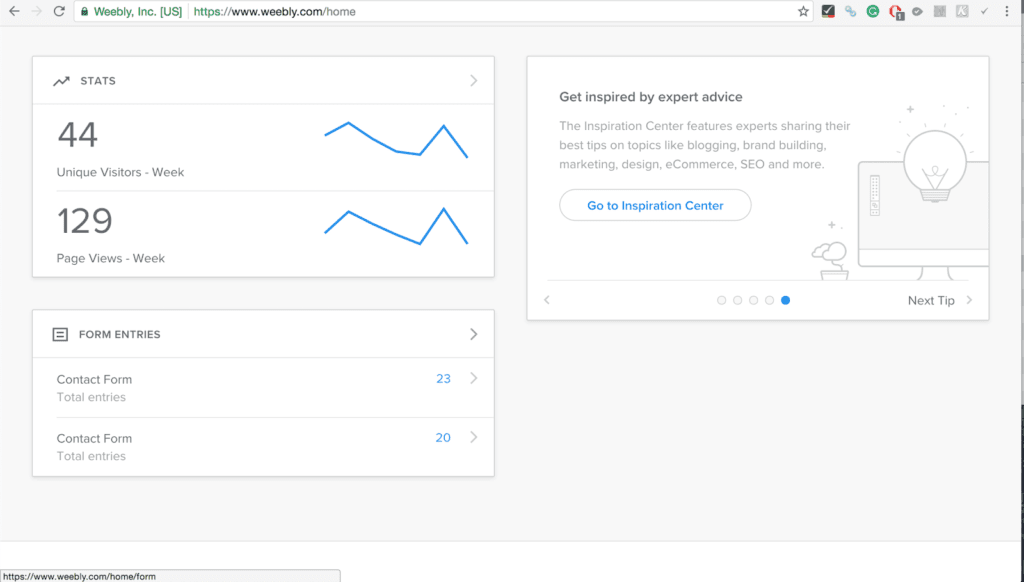
These are the contact forms we received in the first three days of the site going live.
Starting your Facebook business page and mobilizing your network
Once the brand, the look, and the website all went up, it made sense for us to make a Facebook page.
That was the easy part. The next thing we needed was to share it with our network and promote the event we were going to host. So we created our event, entitled Registration Day, where we would physically meet people, tell them about our gym, and have them sign up. We’ll get into the details of that shortly, but for the Facebook page, we gave it a brief description, time, date, and a location. We also made sure to plan it on a weekend that didn’t conflict with any other major events in our community.
Step 4. Organizing, promoting, and hosting our live event
The truth is, we had no idea how to run this event. Prior to this, we just focused on getting people to attend because, otherwise, there was no point in planning it. We hadn’t even confirmed the venue for our event yet, but we had an idea of where we wanted it to be.
Below we’ll discuss what we did, day by day, a week before our event. I work in digital marketing, and although I had never previously launched a business idea of this magnitude, I knew it required careful planning. The time frame of one week was arbitrary, but we felt that seven days would be adequate for building enough hype. But a week, as you can guess, is not a lot of time.
Seven days before the event: Get people excited
We started by utilizing our existing supporters. We sent the following message to our network to let them know we were ready to share our event:
Hey mate,
We're live! We launched our registration event weekend. Like we've said we would love to see some change in the community and we know that with the right people backing it (that is you) we can do it! Any help spreading the word would be AMAZING.
We created our event page here:
https://www.facebook.com/events/1759971847552640/
If you could do your best to share this event on your Facebook at 6 p.m., tonight that would be incredible. We need 100 people to sign up to open, so that’s what we’re aiming to do!
A bit of a heads-up: We’re aiming to have something in the paper this week.
Thanks, mate. You're the best.
- Jonny, Alex and Kale!
The response we received overnight blew us away: 200 likes on our page and 25 people attending our event (60 were interested). It was clear we had hit an underserved spot in the market, and people knew the people who were sharing our content. We had a collective community of 6,500 people who saw this message thanks to our network.
Six days before the event: Get local sponsorships
After a day of our page being live, we received a Facebook message:
Hi there from Subway Cromwell. Do you have a flyer we could put up in our shop to help promote your registration day?
Also, we would be happy to donate some Subway platters for this Saturday to keep you going during your open day.
Give us a call or text in the next couple of days!
All the best
This was pure word of mouth, and subsidized a cost we were going to have to cover ourselves on the event day. We can only assume this came from the buzz around town, as it wasn’t something we expected.
Five days before the event: Draw contracts and get prospect feedback
We had our network share our event and our numbers rose to 270 likes, 30 people attending, and 78 interested persons.
We had to gauge actual interest and intent, and asking people for physical money generally validates your idea. This led us to needing legal work done and gathering feedback forms.
We worked with a lawyer on Fiverr ($12.38 NZD) to get all of our contracts ready, since none of us are lawyers or knew of any. At the time, we weren’t aware of other possibilities, but looking back, if you had tried to do this, you may want to try another better-quality service like LegalZoom. In any case, having these contracts allowed us to sign people up and commit before our opening.
Additionally, we knew we were building the right hype when people were asking us, “When will the gym open?” and “How much will it cost to join?”
They seem like harmless questions, but it’s important to take questions like these as crucial feedback, which can come in handy when you decide what to talk about with future customers on your event day.
Four days before the event: Build local public relations and secure a venue
By now, we had gained ample leverage due to the momentum from word of mouth and Facebook, so we approached our local newspaper in person and asked them to run a piece in the paper about what we were doing. They did. If you try to replicate this step and worry the paper would say no, remember you have a network! Someone is bound to be able to make an introduction.
When approaching a journalist, you generally need to have some compelling information. A journalist isn’t going to cover every single business that just opens up.
We physically went to the office to present our pitch. We outlined the support we had received on Facebook, the support of the local Subway, and that we were trying to create something for the community. This all means there was a compelling story that involves the community and made the journalist look good. They came out that evening to the house to take a picture and the story appeared in the bulletin the next day.
This story added two things to what we were doing: It asked our community to support us, and it brought more credibility to our event. After this story popped up, we shared it on Facebook. Again, we rose to 330 likes, 40 people attending, and 104 people interested.
We used our publicity in the local newspaper as leverage to help us secure our event venue. Our venue was a local mall that was surrounded by other community businesses and located in the center of town. Because of these, it was a prime location for heavy foot traffic.
Before we called the property manager, we emailed to first tell them about our idea. In the email, we made sure to include our Facebook page and the newspaper article. Unfortunately, we didn’t get a reply, but we didn’t give up. Later that day, we gave them a call.
On the call, we simply said, “Can we please use your venue for the next fortnight to test our business? We’re wanting to test if we would like to rent this space for a future gym we’re putting in.”
His answer was a quick yes.
Sending the email and showing him we had done a lot of prior legwork in promoting ourselves made the conversation that much smoother.
Two days before the event: Make a video so people get to know you
We shared a video of myself covering some of my credentials and the upcoming event, which further bolstered the professionalism of our event. We were lucky enough to have a very talented friend help create the video for us, but if you do something like this, you could just as easily shoot something on your smartphone.
Also, we paid $6.89 to promote the video to more people on Facebook, and as a result, it was watched over 350 times and shared four times by people we didn’t know.

Night of event: One final push!
We made one last push with the following message sent to our network:
Hey mate,
This is it! We’re one night away from opening. Our event page and Facebook now has 330 likes, 40 people attending and 120 people interested! This is all thanks to your help, if you could share the event one more time, tonight at 6 p.m., we should be able to hit our goal of 100 people signing up:
https://www.facebook.com/events/1759971847552640/
Everyone will be sharing this again at 6 p.m., thank you so much for being involved and looking forward to sharing the results from the weekend with you!
Cheers,
- Jonny, Alex and Kale!
This brought us to 370 likes, 51 people attending, and 135 people interested in our event. At this point, people were commenting and messaging our page, as well as suggesting ideas they would like to see: a kids' area, different types of classes, and much, much more!
Step 5: Create an event on a budget, and get people to invest in your business
Everything from here on was the culmination of our social media efforts and getting people to physically see our idea. Here we’ll talk about how we:
* Used the ideas and feedback to guide how we wanted our event to run
* Set up our event and dealt with anticipated setbacks
Running the event
Our main purpose here was to see what our customers wanted and what would work before investing $50,000 dollars on a business people may not have wanted.
For our Registration Day event, we conveyed these three principles to the public about its purpose:
1. Be a community-driven project and gather feedback about what the community wanted to see in their gym.
2. Test the convenience of having access to a health and fitness facility 24 hours a day.
3. Bring a level of expertise in our field that couldn’t be purchased from the competition.
The setup and opening the event for our gym
It was crunch time, the time to prepare everything we intended to showcase as our future business. Your event, if you choose to do one, doesn’t need to be perfect. A lot of things can go wrong (they did for us), but the goal is to show people your plans and what they hope to see in the future.
In preparation for setup, we printed pictures of equipment we wanted and taped them to the spots where they would supposedly be once the gym had opened. The purpose was to let prospects imagine their brand-new gym and successfully get them to sign a membership form on the spot (more on that below). We also had photos plastered throughout the inside and outside of the building to let people know where to find us.
It’s important to anticipate what your prospect would need. We created a play area for kids so that people who came by could focus on their needs, rather than their kids’. This, by the way, was based on what a potential customer wrote on our Facebook event page earlier in the week. By the end of day one, this is what the space looked like:

And by the end of the event, we had over 110 people sign up. Here’s what we did to make these people sign up.
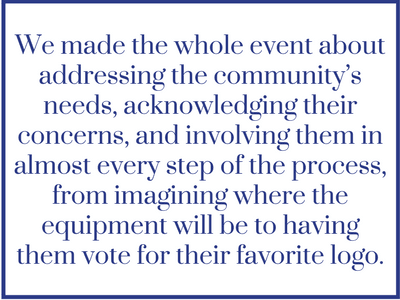
Five things we did during the event to get customer sign-ups
The 110 people that signed up with us wasn’t by accident. We interacted with them in a way that got them to trust and like us. The feedback we had been collecting all week also guided how we treated people when they came in. Here are the main highlights:
1. Got to know each customer’s pain points
We met and greeted each person by shaking their hand and asking for their name. We then asked them about their exercise history to see what they’ve tried, and how they found out or heard about us. Then we based our conversation around the feedback we had heard throughout the week.
2. Asked for more feedback about the gym
We walked them through each picture of the gym equipment on the ground and asked what they thought about the equipment, how they would use it, and where they might place it.
3. Made the “pre-commitment”
We proceeded to get them to the registration table where they filled out their sign-up agreement. We showed them the costs, which were sitting next to the agreement on an open laptop.
If someone said no, we assumed it was because we didn’t communicate with them properly, or they just weren’t ready to sign up. To the latter, we said, “That’s all right, we look forward to seeing you when we finally open.”
4. Got them heavily involved in the vision of our business
Each person cast their own vote on which logo they preferred and which group fitness classes they would like to see in the gym. We then asked each person to leave a signature on the wall.
The reason for all of this is to create social proof, where other people recognize what their friends and family like or approve of. If you see that your friend George, for example, has signed up for the gym, chances are much higher that you’ll do the same.
5. Left a good impression
Just as they left, we shook the person’s hand again and said something like: “Thanks, Nadine. It means a lot that you took your time to be here today. We really want to make this dream a reality. I’m going to ask one more favor: Could you please let three other people who would be interested to get in contact with us or come along today or tomorrow? Looking forward to seeing you when we open up!”
All of this let everyone know we genuinely cared about what people told us, and as a result, we had close to 100 people walk in on our first day, with almost 75 percent of them signed up. They felt like part of our project, and of course, we purposely made them feel that way.
The remaining 25 percent said, “We'll come check it out when you open.” In the future, we would have recruited a lot more friends and family to help out, as there were only four of us.
By the end of day two, we had a 113 memberships and approximately $110,000 of annual revenue before our business even existed.
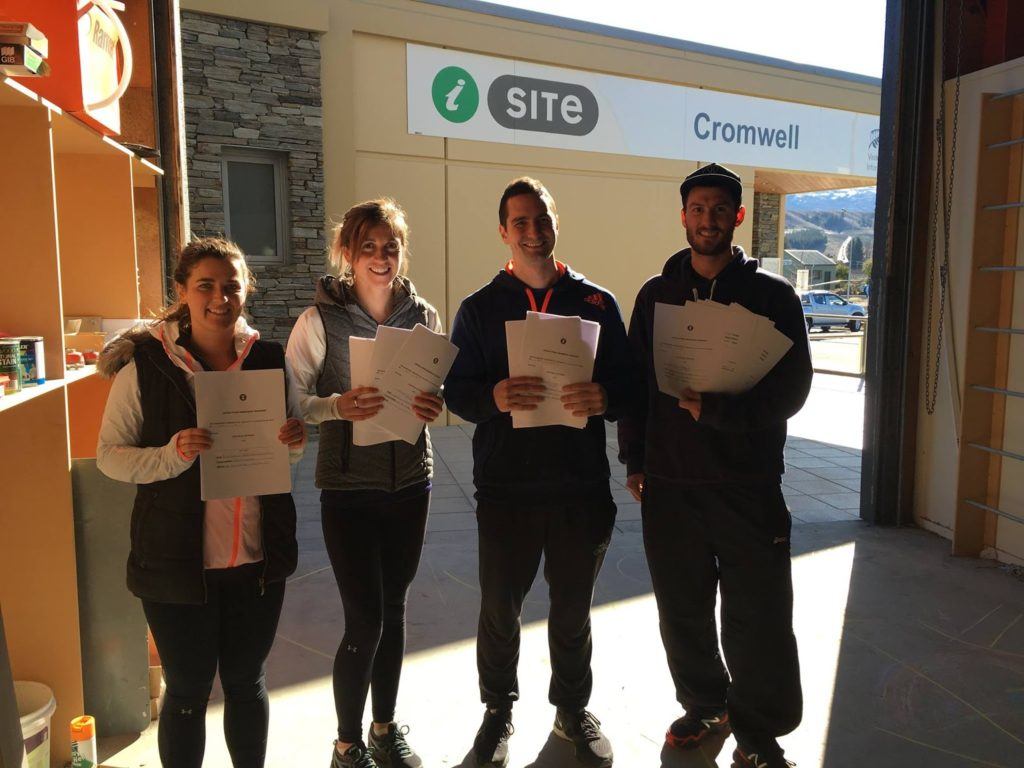
The team and all of their signed contracts
Step 6: The follow-up and promotion
In the very beginning of the article, we explained that we needed to get at least 123 members. We almost reached that goal during the event, but still fell short. In this last step, we capitalized on our new member database to surpass our goal. To do this, we:
* Utilized our new and extended support network to boost further registrations and support
* Created incentives to keep people talking
* Spread our PR efforts wider
Boost further registrations and support
Following the end of our registration weekend, we received seven private Facebook messages that asked if people were still able to sign up. We also recalled a number of people who had attended and told us they had a friend who couldn’t make it that day, but would like to sign up. All of this led us to creating another event the following weekend.
On the Monday evening after the event, we posted a thank you message on Facebook that generated 43 likes and another two messages asking to sign up. Afterward, we added all of our members’ details from the weekend to our email list and sent the first message to our new and improved network. It read:
Hey guys,
We're almost there! We've almost launched Central Fitness but we still need your help! Thanks to all of you who attended on the weekend, we're just shy of our goal. Any help spreading the word from here would be AWESOME.
We're hosting one more registration event this weekend on Saturday only from 10 - 2. If you haven't already, can you please post some support on the link below or come along and have a chat!
https://www.facebook.com/Centralfitness.cromwell/
Remember, everyone who signs up during this time will get a copy of our GET STRONG or GET LEAN nutrition program created by our conditioning coach Kale Panoho in conjunction with Food Sports Scientist PhD student Alex LuBransky.
- Jonny, Alex and Kale
PS: It’d mean the world to us if you forwarded this email to a handful of friends, family, and co-workers, and like this page so we can reach our community goal to open our doors:
https://www.facebook.com/Centralfitness.cromwell/
This resulted in another 16 people emailing us directly to join and created more buzz about the upcoming event on Facebook.
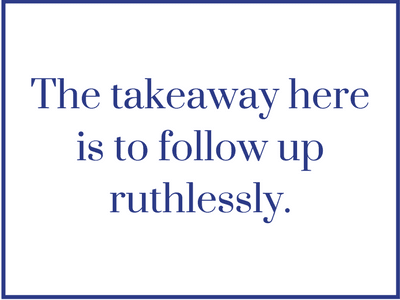
Create incentives to keep people talking with a follow-up event
Encouraged by our momentum from the first weekend event, we created another event the following weekend. We knew people were talking about our events, and in order to capitalize on this, we gave people an incentive to attend and sign up. As a side note, incentives should be based on two things:
1. Offer something people have already asked you about
2. Offer something the competition isn’t doing or isn’t doing well
In our previous research, we knew our competition didn’t offer nutrition plans, so as you might’ve guessed, we offered two types of nutrition plans to attract sign-ups.
On the night before our second event, we released an infographic that I created using Piktochart, outlining the two free types of nutrition plans people were to receive if they joined before we opened.
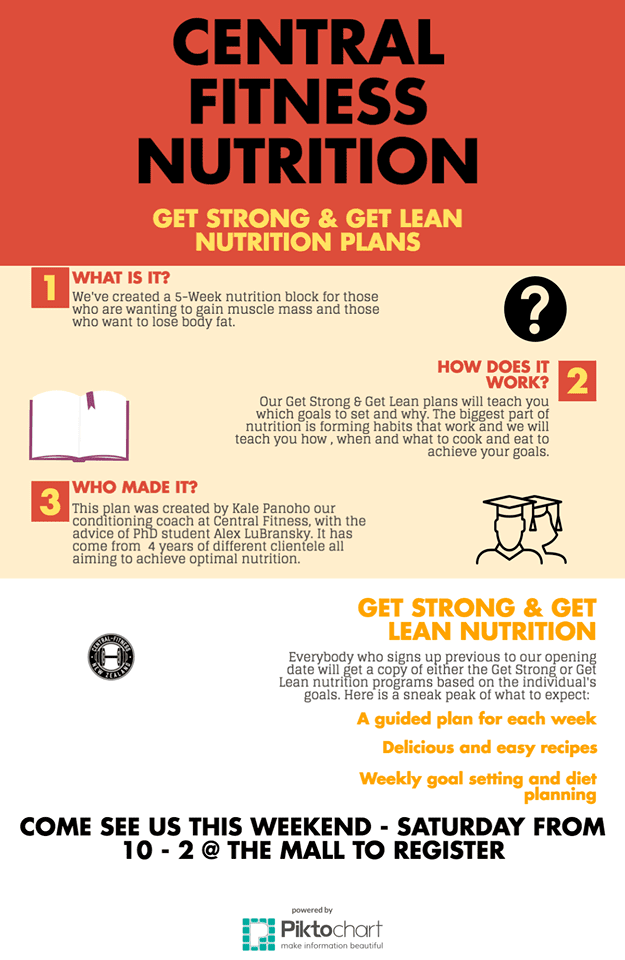
Two messages came in from people asking to join. There were also questions about the nutrition plan. Remember how we viewed questions as feedback? We turned these into major talking points during the event the following day as well.
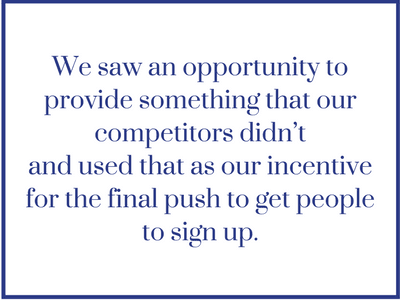
Spread PR efforts wider
The same night we launched our nutrition plan via Facebook, we sent out a second email, asking our network to share our event at 6 p.m. that evening. The email read:
Hey everyone,
We are having one last push to get our threshold of numbers to open up the doors of Central Fitness. The more people we get interested, the better our chance of success.
So we are asking a couple of favors.
Can you all please share our event on your Facebook page: https://www.facebook.com/events/1606780959620355/
Also, can you mention our registration event to the people you meet tomorrow?
Every little bit helps.
Thanks,
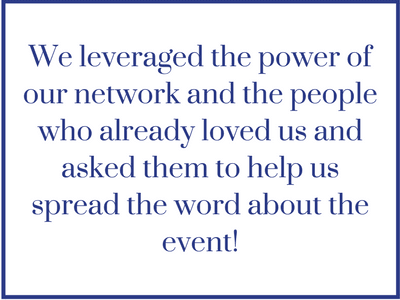
Collect final registrations at our second event
Our second event followed the same formula as the first, though with much better planning. Although the event was only one day, we had another 34 physical sign-ups. This brought our physical memberships up to 147 and digital sign-ups to 36.
After sharing our success again on Facebook, we were approached by a local reporter, who called us directly. She wrote an article about everything that happened in the regional newspaper, which was shared nationally too. The article was shared 19 times across our friends and network without us touching it. This resulted in another 22 people asking to sign up, which brought our final total to 205 members.
Whew…
It was a gargantuan effort that we couldn’t have pulled off without the help of our network. In retrospect, if you look through our advice and what we did, it came down to two things: taking feedback seriously and connecting with other people.
Your biggest goal when providing any service to any person is to make sure their needs are met and that you’re proud of what you’re delivering.


